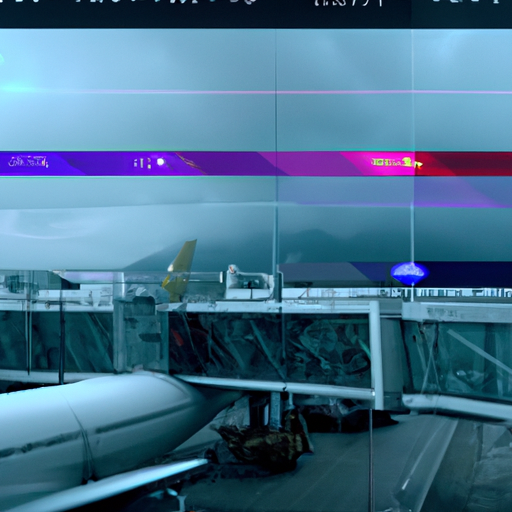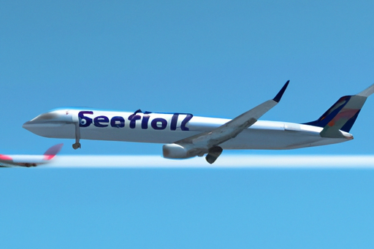
Key Factors Influencing Hong Kong International Airport’s Passenger Traffic Projections
The International Air Transport Association (IATA) has recently updated its passenger traffic projections for Hong Kong International Airport. These projections take into account several key factors that influence the airport’s passenger traffic. Understanding these factors is crucial for both the airport authorities and the airlines operating in Hong Kong.
One of the primary factors influencing passenger traffic projections is the overall economic growth of the region. Hong Kong is a major financial hub in Asia, and its economic performance has a direct impact on the number of passengers traveling through the airport. When the economy is thriving, businesses flourish, and people have more disposable income to spend on travel. This leads to an increase in both business and leisure travel, resulting in higher passenger traffic at the airport.
Another important factor is the growth of the tourism industry. Hong Kong is a popular tourist destination, attracting millions of visitors each year. The city’s vibrant culture, stunning skyline, and world-class attractions make it a must-visit place for many travelers. As the tourism industry continues to grow, more tourists will pass through Hong Kong International Airport, contributing to the overall passenger traffic.
Connectivity is also a significant factor in passenger traffic projections. Hong Kong International Airport serves as a major hub for connecting flights in the Asia-Pacific region. With its extensive network of airlines and destinations, the airport offers convenient connections for travelers from all over the world. As more airlines establish partnerships and expand their routes to include Hong Kong, the airport’s passenger traffic is expected to increase.
The availability of low-cost carriers (LCCs) is another factor that influences passenger traffic projections. LCCs have revolutionized the airline industry by offering affordable air travel options to a wider range of travelers. These airlines often operate from secondary airports and focus on short-haul routes. As LCCs continue to expand their operations in Asia, more passengers will choose to fly through Hong Kong International Airport, boosting its passenger traffic.
Infrastructure development is also a crucial factor in passenger traffic projections. Hong Kong International Airport has been investing in expanding its facilities and improving its services to accommodate the growing number of passengers. The addition of new runways, terminal buildings, and amenities enhances the airport’s capacity and efficiency. This, in turn, attracts more airlines and passengers, further increasing the airport’s passenger traffic.
Lastly, government policies and regulations play a significant role in passenger traffic projections. The Hong Kong government’s commitment to promoting the aviation industry and facilitating travel has a direct impact on the airport’s passenger traffic. Policies such as visa-free entry for certain nationalities and streamlined immigration procedures make Hong Kong an attractive destination for travelers. These policies, coupled with the government’s support for the airport’s expansion plans, contribute to the positive passenger traffic projections.
In conclusion, several key factors influence Hong Kong International Airport’s passenger traffic projections. These include the region’s economic growth, the growth of the tourism industry, connectivity, the availability of low-cost carriers, infrastructure development, and government policies. By understanding and considering these factors, the airport authorities and airlines can better plan for the future and ensure a smooth travel experience for passengers.
Implications of IATA Updates on Hong Kong International Airport’s Growth Strategy

The International Air Transport Association (IATA) recently updated its passenger traffic projections for Hong Kong International Airport (HKIA). These updates have significant implications for the airport’s growth strategy and its ability to meet the increasing demand for air travel in the region.
According to the IATA, HKIA is expected to handle around 8.8 million passengers in 2021, a significant decrease from the pre-pandemic levels. This projection reflects the ongoing impact of the COVID-19 pandemic on the aviation industry and the slow recovery in international travel.
The updated projections highlight the need for HKIA to adapt its growth strategy to the current market conditions. With fewer passengers expected in the coming years, the airport will need to focus on optimizing its operations and enhancing the passenger experience to remain competitive.
One of the key implications of the IATA updates is the need for HKIA to prioritize health and safety measures. As travelers become more conscious of their well-being, airports must implement stringent protocols to ensure a safe and secure environment. HKIA will need to invest in technologies such as contactless check-in, automated temperature screening, and enhanced cleaning procedures to instill confidence in passengers and encourage them to choose the airport for their travel needs.
Another implication of the updated projections is the importance of diversifying HKIA’s airline portfolio. With the decrease in passenger numbers, the airport will need to attract new airlines and routes to maintain its connectivity and ensure a steady flow of passengers. This may involve offering incentives to airlines, such as reduced landing fees or marketing support, to encourage them to operate at HKIA.
Furthermore, the IATA updates highlight the need for HKIA to focus on domestic and regional travel. With international travel still facing uncertainties, the airport can tap into the growing demand for domestic and regional flights. By working closely with local airlines and promoting Hong Kong as a regional hub, HKIA can attract more passengers and stimulate the recovery of the aviation industry in the region.
The updated projections also emphasize the importance of collaboration between HKIA and other stakeholders in the aviation industry. This includes working closely with airlines, government authorities, and industry associations to develop strategies that support the recovery and growth of the airport. By fostering strong partnerships and aligning their efforts, HKIA can leverage the collective expertise and resources of these stakeholders to overcome the challenges posed by the pandemic and position itself for long-term success.
In conclusion, the IATA updates on HKIA’s passenger traffic projections have significant implications for the airport’s growth strategy. To adapt to the current market conditions, HKIA must prioritize health and safety measures, diversify its airline portfolio, focus on domestic and regional travel, and foster collaboration with other stakeholders. By doing so, the airport can navigate the challenges posed by the pandemic and position itself for a strong recovery and future growth.
Analyzing the Potential Impact of IATA Updates on Hong Kong’s Tourism Industry
The International Air Transport Association (IATA) recently updated its passenger traffic projections for Hong Kong International Airport. This update has sparked interest and speculation about the potential impact on Hong Kong’s tourism industry. In this article, we will analyze the potential implications of these updates and what it means for the city’s tourism sector.
Firstly, let’s take a look at the updated passenger traffic projections. According to IATA, Hong Kong International Airport is expected to handle around 8.8 million passengers in 2021, which is a significant decrease from the previous projection of 29.3 million passengers. This sharp decline can be attributed to the ongoing COVID-19 pandemic and the subsequent travel restrictions imposed by various countries.
The revised projections indicate a challenging road ahead for Hong Kong’s tourism industry. With fewer passengers expected to pass through the airport, it is likely that the number of tourists visiting the city will also decline. This could have a negative impact on the local economy, as tourism plays a vital role in driving economic growth and creating employment opportunities.
One of the key concerns arising from these updates is the potential loss of revenue for businesses in the tourism sector. Hotels, restaurants, and tour operators heavily rely on tourist spending to sustain their operations. With fewer visitors, these businesses may struggle to generate sufficient income, leading to job losses and financial difficulties.
Furthermore, the decline in passenger traffic could also affect the overall image and reputation of Hong Kong as a tourist destination. The city has long been known for its vibrant culture, stunning skyline, and world-class attractions. However, if the number of tourists dwindles, it may be perceived as a less popular destination, which could deter potential visitors in the future.
On a positive note, the updated projections also highlight the importance of adapting and diversifying the tourism industry. Hong Kong has always been a resilient city, capable of reinventing itself in the face of challenges. This situation presents an opportunity for the city to explore new avenues and attract different types of tourists.
For instance, Hong Kong could focus on promoting domestic tourism to compensate for the decline in international visitors. By encouraging locals to explore their own city, the tourism industry can still generate revenue and support local businesses. Additionally, Hong Kong could also target niche markets such as eco-tourism or cultural tourism, which may appeal to a specific group of travelers.
In conclusion, the updated passenger traffic projections for Hong Kong International Airport have raised concerns about the potential impact on the city’s tourism industry. With fewer passengers expected to visit, businesses in the tourism sector may face financial challenges, and the overall image of Hong Kong as a tourist destination could be affected. However, this situation also presents an opportunity for the city to adapt and diversify its tourism offerings. By exploring new avenues and targeting different markets, Hong Kong can continue to thrive as a vibrant and attractive destination.


